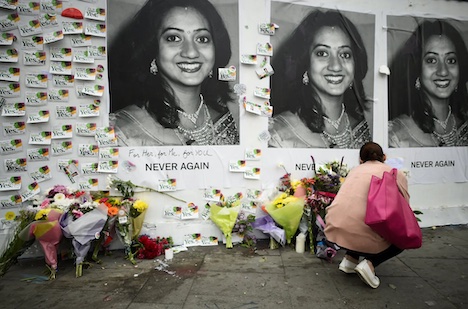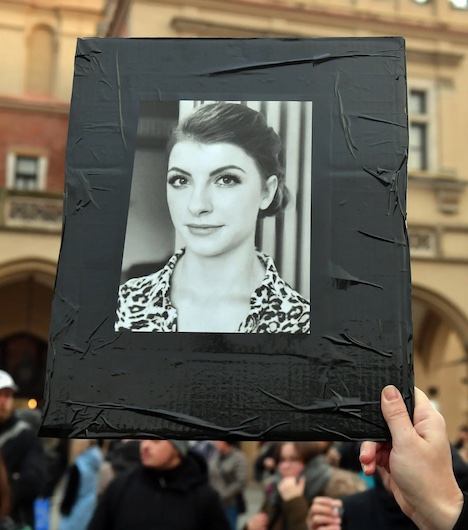|
By Sarah Wildman | NYT
from New York Times
Monday, Nov 29, 2021
The Women Who Died After Abortion Bans
 |
| Savita Halappanavar of Ireland became ill and died after being refused an abortion as she miscarried.Credit...Clodagh Kilcoyne/Reuters |
In 2012, Savita Halappanavar, a 31-year-old married dentist, appeared at Ireland’s University Hospital Galway in pain. She was 17 weeks pregnant and miscarrying. According to Dr. Halappanavar’s husband, hospital staff said that there was no saving the pregnancy, but they refused to intercede because her fetus still had a heartbeat. She was told her only option was to wait.
Dr. Halappanavar became feverish. By the time the fetal heartbeat faded away, she was in organ failure. Two and a half days later she was dead.
Nearly three decades earlier, Ireland’s leaders created one of the world’s most restrictive abortion laws with an amendment to their nation’s Constitution, cementing Ireland’s near-total ban on abortions. After that, women who were able left the country for the procedure, while those who couldn’t lived with the consequences of the law. The amendment remained in place despite many stories of related brutality during that period, including a suicidal 14-year-old girl who was impregnated through rape. Her family had to plea to the highest court in the nation for her to even travel for a termination. She lost her case at first, but mass protest prompted the court to reconvene, and she was ultimately allowed to travel to Britain for an abortion.
Dr. Halappanavar’s story had an even greater impact. When she died, her husband stepped forward immediately and said Ireland’s restrictive abortion laws were to blame in her death. Her death created a surge of grief and anger that became a focal point of the abortion and women’s rights movement in Ireland, and contributed to the drive to overturn the country’s constitutional amendment.
“People would say, ‘This is for Savita,’ and she came to symbolize all women who had to struggle and suffer because of that ban,” an Irish abortion rights activist, Ailbhe Smyth, told me. In 2018 Irish voters finally overturned the amendment.
In the United States, with Roe v. Wade likely to be largely dismantled, if not overturned, next year, it is time to look again at the women whose lives — and deaths — changed how the public understands what’s at stake when we talk about banning abortion.
“The thing I worry about in the United States is that the rallying cry won’t happen until women die, and that’s so unnecessary and unfortunate,” said Kathryn Kolbert, who in 1992 argued the major abortion case Planned Parenthood v. Casey before the Supreme Court.
It should not take a high-profile death to expose just how much is at risk when medicine is hamstrung by politics, religion or culture. And yet, interviewed for The New York Times, women across Ireland described how learning about Savita Halappanavar’s story had woken them up to the reality that their very lives were on the line — not only if they found themselves facing an unwanted pregnancy, but also if a wanted pregnancy went wrong.
When you look at which stories have fueled abortion rights activism in other countries, Ms. Kolbert’s worry seems well founded. In September a 30-year-old mother identified in the press only as Izabela arrived at a Polish county hospital. According to a lawyer for her family, she was 22 weeks pregnant and the prognosis was poor: There was little or no amniotic fluid, and sonograms showed the fetus bore abnormalities. Still, a heartbeat remained.
Last year the Polish high court struck down a provision in the country’s already draconian abortion law that allowed for abortion in cases of fetal abnormality.
Izabela knew that her situation was grim. She sent a text message to her mother from the hospital: “The baby weighs 485 grams. For now, because of the abortion law, I have to lie down. They can’t do anything. They are going to wait until he dies or something else happens. Oh and also, I could die of septic shock.”
 |
| A photo of Izabela at a protest in Krakow, Poland.Credit...Alex Bona/SOPA Images/LightRocket, via Getty Images |
In time, the fetus died. Then Izabela died, too.
(“Doctors and midwives did everything in their power, they fought a difficult battle for the patient and her child,” the hospital said in a statement.)
Eventually, Izabela’s mother made her texts public. Days later, in early November, Polish protesters marched with signs that said, “Her heart was beating too” and “Not one more.” In apparent response to the protesters, Poland’s health ministry “clarified” the nation’s abortion law, insisting that the procedure remains available to save the life of the pregnant woman.
Storytelling, Ms. Kolbert pointed out, has always been a tool in the arsenal of the political movement to safeguard abortion rights, or to win them in the first place. In recent years, the focus among activists in the United States has shifted away from telling stories of dangerous back-alley abortions and become one of empowerment, focused on sharing stories that help remove the stigma and shame that still clings to the procedure.
But in the years before Roe, clergy, legislators, media and feminist activists hoped that telling women’s stories of victimization, humiliation and death could humanize the need for universal abortion access and bring about legalization. One such story began with a 1964 police photo of a woman’s bloodied, lifeless body, facedown on a motel carpet. The woman was Geraldine Santoro, known as Gerri, 28 and a mother of two. Ms. Santoro had been fearful of what her estranged and violent husband would do to her if he discovered she was pregnant with a lover’s child. Her boyfriend attempted to perform an abortion on Ms. Santoro, accidentally killing her in the process. (He fled and was later convicted of manslaughter.)
That photo of Ms. Santoro was published in Ms. magazine in 1973, under the words “Never Again.” The image was blown up on placards carried at abortion rights rallies, a visceral illustration of the risks of illegal abortion.
In recent years, the state of abortion rights in America has deteriorated, especially for poor women and women of color. But it may be harder to motivate protesters now, in an era where women of reproductive age have spent their entire lives with the protections of the Roe era. The back-alley abortions that motivated the movement in the past are largely someone else’s memory.
There are other fears now. Today, a person could be charged with a crime after miscarrying or could face legal consequences for ingesting abortion pills ordered on the internet. In states where abortion access has been whittled down, legal provisions promising to safeguard the life of the pregnant woman are left to interpretation by medical personnel. But this is a space without clear answers, and hospital staffs will inevitably factor their own legal and professional risk into what would otherwise be a decision about the patient’s best interest.
Texas’ law banning abortion after about six weeks of pregnancy has been in effect since September, and already, The Lily has reported, a woman in the state who experienced an ectopic pregnancy said she was turned away for care. Ectopic pregnancies, in which a fertilized egg implants outside the uterus, require immediate termination because they endanger the patient’s fertility or, worse, her life. In theory, terminating an ectopic pregnancy is not banned under the Texas law. But in this case, according to the National Abortion Federation’s hotline director, who spoke with The Lily, doctors were afraid to intercede, and the woman ended up driving at least 12 hours to New Mexico for the procedure.
The Texas woman with the ectopic pregnancy survived her ordeal. But as more states consider passing laws like Texas’, the next woman might not. What will happen then? Will we know her name? Will she become a rallying cry? Or will she and other women with tragic stories fade into obscurity, their families fearful of coming forward? No one wants to see this happen, but what are we doing to prevent it?
I called up Lynn Paltrow, the executive director of the National Advocates for Pregnant Women (who happens to be my cousin by marriage), and asked her: Why does tremendous outcry over restrictive abortion laws come after a woman dies, rather than before? Ms. Paltrow was biting in her response. “The primary impact of the anti-abortion movement has not been to stop abortions, it is to dehumanize,” she said. “It is martyrdom and the visible suffering and death of a visible woman that reminds people of their humanity and their right to life.”
In Texas and elsewhere, Americans shouldn’t wait for another woman’s heart to stop beating before they demand change.
Source URL
|
 Print This Print This

|

